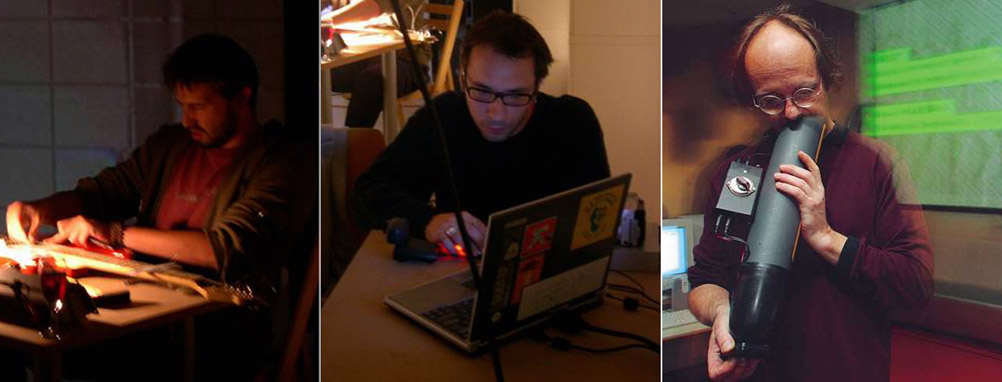
PROBLEMLOß ORCHESTRA = PMS (PRINČIČ / MANČEK / SAVSKI)
2005 – 2006 (r.i.p….)
– an experimental sound performance (=concert?) project group from Slovenia…
– experimenting with sound (and objects as instruments) as metaphore…
– other faces:
http://www.kataman.org/slo/problemloss-orchestra.html
Appearing:
– in Kapelica gallery Ljubljana, may 2005
– in Moderna gallery Ljubljana, september 2005
– in Dobbia near Monfalcone, march 2006
– in Berlin, may 2006 (no sound recordings… but Neven Korda did a video excerpt -> see the player ->)
– in Club 5 Wien, june 2006
– in ESC gallery Graz, september 2006
– in Kapelica gallery Ljubljana, november 2006
Play file1
Play file2
Play file3
Play file4
photos from Vienna -> http://viator.si/photop/06-06-20__club5_the_insistant_clubscene_vienna/
other photos -> Problemloss
Problemlos Orchestra (PMS orkester; Princic, Mancek, Savski) naj bi se ukvarjal s prepletanjem zvocnih identitet/entitet v zvocni tok – zvocno dramo, ki tako ali tako vedno nastane, ko se nekaj raztegne v casu. V glavnem se vsak posebej ne ukvarjamo s podrobnostmi skupnega nastopanja, razen med nastopom samim. Tu gre za poudarek med razlikovanjem real-timea (zivega nastopa) in konstruiranega casa – t.j. predpriprav (kompozicije, osmisljevanja, gradnje). Slednje seveda obstaja, vendar na malce drugacen nacin.
Problemlos Orchestra (PMS; Princic, Mancek, Savski) is supposed to deal with interweaving of sound identities/entities into a flow of sound – a sound drama, which is known to emerge always, when something is extended in time. We usually don’t deal with topics of combined performance, except during a performance itself. Here we try to stress the importance of the difference between the so-called real-time (a live improvised performance) and the constructed time – meaning: preparation before the performance (composition, structuring, building). The composition therefore exists, but iin a slightly different manner.
Kompoziciji pristopamo na razlicne nacine – z gradnjo taksnih ali drugacnih zvocil (zvocnih strojev, vmesnikov). Ti so mehanski, elektricni, elektronski (mehatronski), racunalniski – v principu pa imajo vsi praviloma ze svoje zivljenje (neke vrste dinamicno inercijo, ali drugace povedano: lastno algoritmicno strukturo). Pa tudi psihofizicne in socialne dejavnike bomo morali pocasi izpostaviti.
We approach the composition in various ways – with building of different objects of sound and thought(interfaces, sound machines). These can be mechanic, electric, electronic (mehatronic), computer – but in principle they already sustain a kind of a life of its own (a kind of dynamic inertia, or: own algoritmic structure). We should also try to point out to the psycho-physical and social motivations/motivators/machines.
Vse skupaj se v celoto zliva na neki abstraktni ravni (torej kot zvok), kjer vsak od nastopajocih priblizno dirigira svoje “potujene reprezentante”. Potujene v smislu relativne velike “odmaknjenosti” od nacina vnasanja sprememb – t.i. muziciranja. Ta nacin omogoca razmeroma odmaknjeni (in torej kar verodostojen) pogled na dramaturgijo.
Na Dunaju je bil doslej (se mi zdi) peti primer skupnega nastopa, kjer je Nova uporabil racunalniski sistem granularne sinteze in posebnega vhoda za slehernika z na Dunaju najdenimi elektricnimi orglami. Mancek je uporabljal elektricno kitaro z orodjem za mehanike in digitalnimi efekti, Savski pa racunalniski algoritem s posebnim interfejsom, sestavljenim iz video kamerice, racunalniske tastature in nekaksnega instrumenta, ki morda spominja na “dvojnice s spiralo”. Nova je o koncertu dejal, da ima doslej najboljsi obcutek, tudi Mancek se je kar strinjal, Savski pa je dejal, da je bil tudi Berlin ze kar v redu.
The concert in Vienna was our fifth performance, and Nova used the computer system of granular synthesis with a special “door”/entry point for the someone from the public to plug-in (the interface was the bontempi organ found in Vienna). Mancek used his electric guitar with his apple mechanical toolbox and the digital effects, and Savski used a computer algoritm with an interface composed of webcam, computer keyboard and a midi interface of some kind. Nova said after the concert that he had the best feeling so-far, Mancek agreed, and Savski said that also Berlin was quite good.
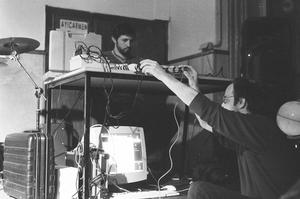
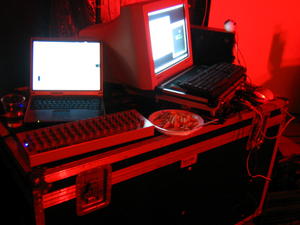
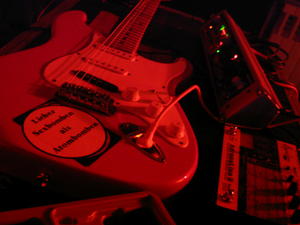
…………………………………………………………………………………………………………………………
The background = first (=second) appearance:
Posodi polni zvoka / o fluidnosti prostora
Bowlfuls of sound / About fluidity of space
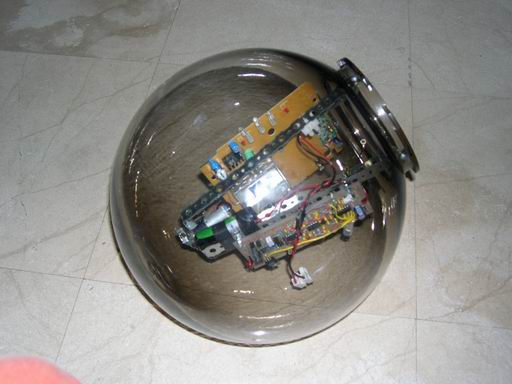
Kljub predvidoma samostojni zaključenosti (pojavne estetike) nastopa trojice Borut Savski, Luka Prinčič in Matjaž Manček (zvočni / glasbeni nastop = koncert), pa je morda vseeno vredno opozoriti, identificirati posamezne kose, ki sicer bolj ali manj neodvisni, združeni skupaj tvorijo koncept (strukturo / zgradbo / dramaturgijo) dogodka.
In spite of the, hopefully, self-sufficient aesthetics of the sound performance by Borut Savski, Luka Prinčič and Matjaž Manček (sound / music performance = concert), it may be worth mentioning or identifying the separate pieces, more or less independent, that together form the concept (the structure / the composition / the dramaturgy) of the event.
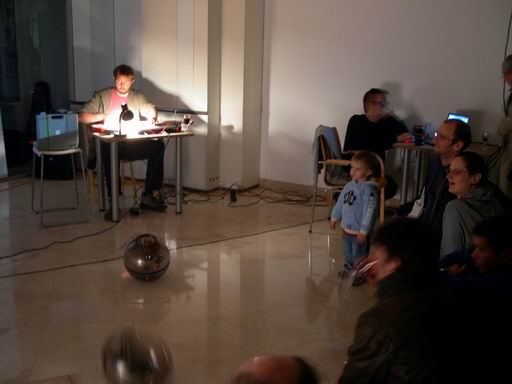
Izhodiščni domislek o dveh gibajočih se, eno na drugo nanašajočih se kroglah (-> posodah, polnih zvoka), se na koncu (tega besedila) sestavi s pričujočim razmislekom o fluidnem prostoru, ki naj bi ga na zvočnem dogodku vsi mi začutili in zaradi neposredne izkušnje morda tudi doživeli kot morebitni katarzični moment.
The primary idea of the two moving, mutually corelated spheres (-> bowlfuls of sound), in the end (of this writing) connects with some ideas of a fluid space, which we would like achieve at the event and maybe, because of the personal experience, take as a kind of catharsic moment.
The fluidity is (here) of course measured in the field of sound (since we are sound artists). Fluidity means, that the present masses can relatively easily move one past another, they can spiral together, circulate at will, but almost never hit hard on each other. Because of the softness of materials there is no hard confrontations. The dynamic changes in one object / sound are softly transfered to the edge of space – at some points exhibiting resonance, at other points they die out. Of course this is the metaphorical language – of a world softer and more open.
In opposition to any fluidity stands – the hardness of material. The hardness of fixed relations, of immense inertia – the inert space. In such a space nothing ever happens, all is known, all questions have answers. The measure of inertia are inertias of relations between the objects / entities in a given space. The relations change slower than we can observe – so they seem unchanging. The fluidity of space means shortening of the reaction time of such relations, to provide the ability to observe the passing of time.
But it is only from a fixed viewpoint that we can observe what we measure – to see the changes. Therefore we need a construction of the situation – the event.
Konstrukcija / kompozicija zapoveduje:
Dve kroglasti posodi sta opremljeni z enostavno motoriko in bolj kompleksno senzoriko. Občutljivi sta za zvok, ki ga slišita, a ga tudi proizvajata (nadzirana mikrofonija). Od tod tudi teza, da sta posodi polni zvoka. Eno drugo lahko tudi zaznata (infrardeči senzor) in tedaj spremenita smer. To naj bi omogočilo postopno cikcakasto približevanje posod, kar pa nas ne zanima več, a za posodi je to nekaj, čemur lahko rečemo vodilo / motiv (pri človeku bi to imenovali celo smisel). Preprosta samonanašajoča se algoritmika proizvede / rodi nekakšno avtonomijo stroja.
Construction / composition is defined by:
Two sperical bowls have simple motorics and a bit more complex sensorics. The are susceptible to the sound they hear, but they also coproduce the sound (compressed microphony). This is why the bowls are full of sound. They can see each other (infrared sensor) and then they change direction. This should allow for the bowls to slowly zigzag closer to each other, which doesn’t really interests us anymore, but for the bowls this may be defined as a motive (with human it could be called the sense). A simple autoreferential algorithmics produces / gives birth to a kind of autonomy of the machine.
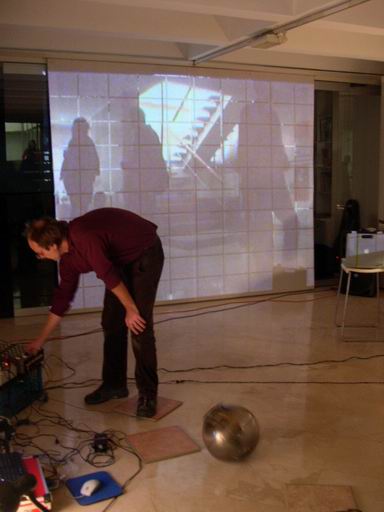
Dve opisani kotaleči se krogli tako postaneta ovčici in potrebujeta pastirja. Vendar je bil pastir (s palico) prisoten že prej! To je želja muzikanta, ki je imel željo po konkretnem zvoku – rezek, glasen udarec s palico. Posodi tako zaradi pastirja postaneta ovčici. Palica ob dodatku zvočno občutljive podlage postane glasbeni inštrument. Prav to pa lahko določi tudi kvaliteto preostalega igranja. Mehak zvok posod in rezkost udarcev ob tla in po strunah.
Tretja entiteta (ker smo muzikanti trije) se je kristalizirala okoli manipulacije podobe in pretvorbe v zvok. To algoritmiko poganjajo vizualni podatki neposredno s samega prizorišča, tako da smo v ta segment kot spremeljivke vključeni vsi prisotni. Projekcija nas samih v prostor pred / za nami bi lahko bila priložnost za nov aspekt, a bodi dovolj. K fluidnosti bomo dodajali še z enim pomagalom – s spreminjanjem položajev posameznik zvokov med štirimi zvočniki.
The two wobbling spheres thus become two sheep and need a shepherd. But the shepherd (swinging the stick) was there before! It is a wish of a player who wished for a very concrete sound – sharp, loud hit. The bowls become sheep only because of the shepherd. The stick played on an active background become a musical instrument. It can define the quality of the rest of the sound. The soft drone of bowls and the sharpness of the hits against the floor and the plucks against the strings.
The third idea / object (since we are three) have crystalized around the manipulation of image and translation into sound. This algorithmics is powered by the visual information fed in directly from the event, so that we are all included into this segment. The projection of us in the space in front / at the back could be a lead to another aspect, but let it be enough. We will add to fluidity with one more approach – the changing of the positions of sounds among the four loudspeakers.
before the first (=second):
Soundtracks Live @ Moderna 20th September 2005:
track 1
track 2
track 3
track 4
track 5
track 6
track 7
On 12th of April 2005, after the end of presentation of a Dancer installation a group of four of us (DJ Nova = Luka P, Matjaž Manček, Petra Tihole and Borut Savski) performed an improvised session, that came out well, so you can listen to it ALL here… (over 50 minutes, mp3)
Avtorji / izvajalci:
Authors / performers:
Borut Savski
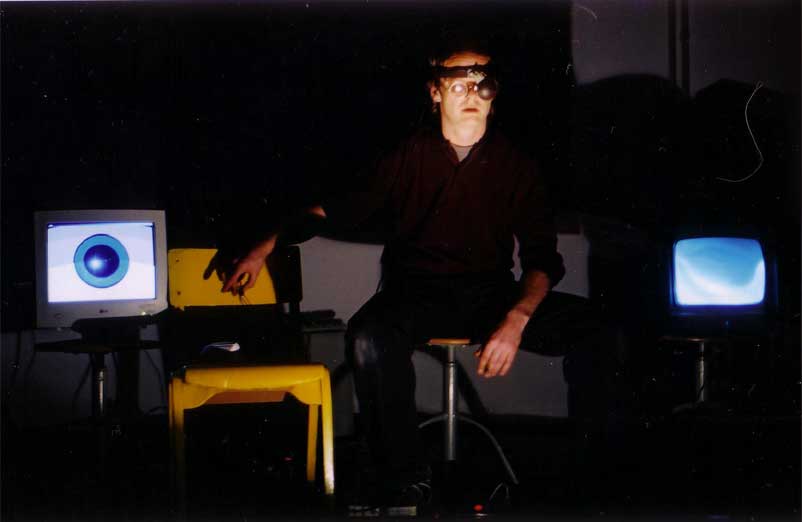
Neumorni eksperimentator z zvoki in zvočnimi viri ter izumitelj številnih nevsakdanjih zvočnih naprav.
Junija 1999 je v galeriji Kapelica, skupaj z ameriškim umetnikom Johnom Grzinichem, postavil svojo prvo zvočno instalacijo Zvočni biotop, ki temelji na uporabi samonanašajočih se (kibernetskih, avtopojetskih) gradnikov. Konec leta 2000 je napisal esej “Estetski stroji”, ki ga je v treh delih predstavil v oddaji Umetni svetovi na Radiu Slovenija, v začetku leta 2003 pa je izšel kot del zbornika Etika in estetika pri Študentski založbi. Sledili so projekti: „Okrogla miza“/2001, „Sonično gledališče“/2002, „Estetski stroji“/2003, „Orodje-orožje“/2004, „Truba“2004, „Eye=I“/2004, „Orakelj“/2004, „Plesalec“/2005 in „Posodi polni zvoka“/2005.
Več: http://www.3via.org/index.php?htm=borut/index.
Born in 1960, Ljubljana Slovenia. Studied at Faculty for Electrotechnics, Ljubljana. Joined Radio Student Ljubljana in 1984, worked as technician, producer, music critique,…
In 1993 employed at Radio Student Ljubljana as chief coordinator, took part in many new projects arising around Radio Student and internationally. Quit this job in 1997, started coordinating Ministry of Experiment, an open platform for various media research, started to learn about internet. Co-organized web and radio based Xtended Live Radio events in 1997. During 1997-99 performed about a hundred of direct radio broadcasts from clubs, homes – events with portable transmitter to airwaves of Radio Student (“amplification of underground activities”). Invited to take part in web activities at Ars Electronica 1998. Started a regular radio broadcast “Huda ura” (Heavy Weather) in 1999 presenting sound art within the (not so broad) concept of algorithmic=improvised – about half of the time is dedicated to describing the concept and production itself – I produced a host of algorithmic sound examples. I got interested in various systems’ theories – also based on experiences with small human systems. In 1999, together with American sound artist John Grzinich, realized a sound installation “Sound Biotope” in Kapelica Gallery in Ljubljana. In 2000 – soundtrack for a cartoon (E-Motion Film production). In 2000 split with Ministry of Experiment as a platform. In 2001 wrote an essay “Aesthetic Machines” – not yet translated. Following projects: „Holy Trinity/Round Table“/2001, „Sonic Point Of View“/2002, „Aesthetic machines“/2003, „Bazooka-Electric Jesus“/2004, „Eye meets I“/2004, „Oracle“/2004, „The Dancer“/2005 and „Bowlfuls of sound“/2005.
Check http://www.3via.org/index.php?htm=borut/index.
Matjaž Manček
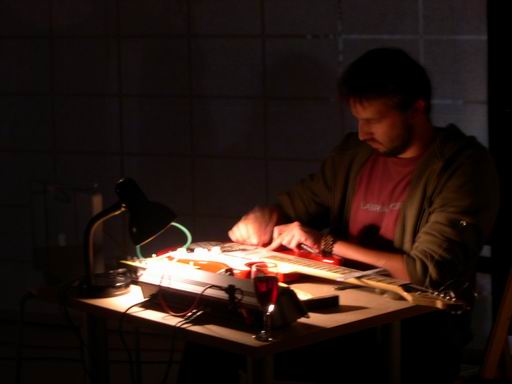
Glasbenik, koncertni organizator, radijski aktivist, promoter in praktik glasbene improvizacije. Nekdaj kitarist noise-rock ansambla Štirje pravi dedci, trenutno igra v zasedbah Bast in Alzheimer Trio. Sodelavec pri projektih in zvočnih nastopih Boruta Savskega od 2002.
Started its musical path as clarinet player in local brass band, soon switched to guitar and noise-rock group Štirje pravi dedci. Few years ago started to collaborate with jazz-rock band Lolita and impro-jazz project Lolita Libre. Recently mostly occupied as member of experimental/multimedia music project BAST and an improv group Alzheimer Trio. Since 1996 involved in various music-related activities and actions: music editor, journalist and dj at Radio Student, club dj, promoter, organizer of various festivals and music series (rock, improv, electronic), editor of experimental electronic label rx:tx, coordinator of series of impro events at club Gromka,…
www.radiostudent.si, www.crossradio.org, www.rx-tx.org, www.zavod-parasite.si/soundexplicit, www.rx-tx.org/progress, www.ljudmila.org/stripcore/sc8999/dedci.
Luka Prinčič
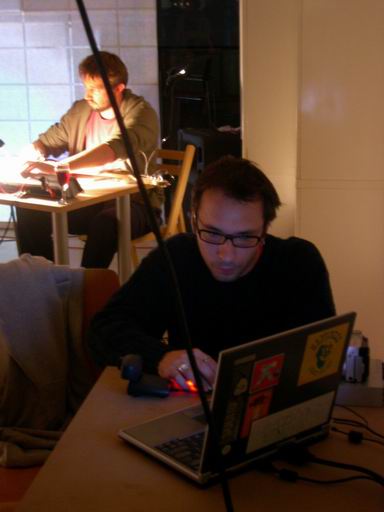
Diplomant londonske SAE Technology College, prosti glasbenik, zvočni oblikovalec, dj (znan kot DJ Nova), programer, umetnik in raziskovalec digitalnih oblik zvoka, glasbe in njih odmevov v teksturi družbenega in emocionalnega. Večino svojega dela, ki se vrti okoli vprašanj svobodnega izražanja, anartivizma in mreženja, bazira na naredi-sam copyleft etiki in objavlja pod prostimi licencami ali daje v javno last. Prinčič je tudi avtor internetnih projektov http://skylined.org in http://www.letusplay.net.
With a Recording art degree (BA) of SAE Technology College London in his pocket, Princic is free musician and sound designer, dj, programmer, artist and reasearcher of digital forms of sound and its echoes in the social and emotional textures. His work focuses on issues about free artistic expression, anartivism, networking, do-it-yourself and copyleft etics. Prinčič is also creator of internet projects: http://skylined.org,http://www.letusplay.net.
 my RSS
my RSS